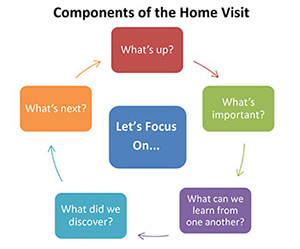Family-Centered Early Intervention for Children with Hearing Loss
When a family learns that their child is deaf or hard of hearing, they enter a whole new world. This unfamiliar world is full of new terminology, paperwork, evaluations, and professionals that they did not know existed. The role of the early interventionist is to help families navigate this new territory by providing emotional support, accurate information, and necessary resources. Supporting families during this time requires an interventionist with strong interpersonal abilities and specialized knowledge and skills. This knowledge and skill base must include the following areas:
- Family systems and routine-based intervention approaches
- Child development: communication, auditory, physical, cognitive, social-emotional, adaptive behavior
- Potential impact of being deaf or hard of hearing on development
- Communication approaches and language facilitation strategies – with a willingness to explore which strategies best fit the strengths and needs of the child and family
- Amplification and listening technologies – with both a technical understanding of the technologies and a dedication to collaboration with audiologists and other professionals
- Authentic assessment approaches for monitoring child development
- Cultural competence – recognizing the importance of families’ unique values and cultures
- Counseling, adult learning styles, and reflective listening skills
- Community resources
At the foundation of family-centered early intervention is the home visit. Although each family’s circumstances are unique and each home visit is different, there is an underlying structure that supports the quality of each visit.
Components of the Home Visit

Carotta, C., Cline, M.K., & Brennan, K. (2012) adaptation of Moeller, M.P., & Stredler Brown, A. (2004). The Art & Science of Home Visits.
What’s up? At the beginning of each visit an interventionist should take time to reconnect with a family and address any questions and concerns that have arisen since the last visit. During this time, the family may share and celebrate progress their child has made and also discuss challenges and frustrations. This conversation helps the family and interventionist find common ground.
What’s important? As the family and interventionist reconnect, the family’s priorities will begin to surface. The interventionist must set aside professional agendas and respect what is currently most important in the family’s life. Supporting the family in the process of identifying goals that are most important to them creates a meaningful context for the visit.
What can we learn from each other? Once priorities are established, the family and professional join together to identify and capitalize on communication opportunities during daily routines. The interventionist and family members explore ways to seize opportunities during the day to promote listening and communication. The primary goal for the professional is to coach the parent to discover and use developmentally-appropriate strategies during parent-child interactions. While the parent uses strategies during daily routines, the interventionist can observe their strategy use and provide on-the-spot commentary about what the parent is doing and how the child is responding. This models the important skill of using observation to guide next steps.
What did we discover? After parents experiment with implementing various techniques with their child, they are encouraged to reflect on the visit and identify what they learned. The interventionist and parents work together to determine which strategies were most successful. They can then discuss ways to modify techniques to meet the individual needs of the family and the child. Honest communication is necessary for ongoing informal evaluation of strategies and techniques. Continuous charting of progress through authentic assessment strategies helps identify areas of growth and areas of further need.
What’s next? After parents and interventionist evaluate how the visit went, they can brainstorm the most effective ways to implement strategies throughout the week at home. This is also a time when the interventionist may ask the family to identify areas or topics when they are feeling unsure of their skills or knowledge. This brainstorming discussion will assist the family and interventionist in deciding the areas of focus for the upcoming days or weeks.
Let’s focus on... At this point during a home visit, the parents and interventionist agree upon the area of focus and think of the most effective ways to target them in the home. Together, a specific plan is created for the upcoming week(s). Daily routines specific to the family are identified as times to practice certain strategies with their child. Depending on the learning style of the parents, a written and/or visual reminder of the plan will be given to the family. During the next visit, parents will be asked to share their insights about the week’s activities including how they felt implementing the strategies and how their child responded. When parents can identify what works best for their family, they feel successful and are invested in continuing those strategies in their everyday life.
Early interventionists strive to help parents understand their important role as their child’s primary language facilitator. The partnership that develops between an early interventionist and a family can be a powerful tool to enhance a family’s understanding of the unique needs of their child and build their confidence in supporting their child’s development within his or her natural environment.
Carotta, C., Cline, M. K., & Brennan, K. (2012). Auditory Consultant Resource Network Handbook. Boys Town National Research Hospital.
Moeller, M. P., Schow, R. L., & Whitaker, M. M. (in press). Audiologic rehabilitation for children: Assessment and management. In R. L. Schow & M. A. Nerbonne (Eds.),
Introduction to audiologic rehabilitation (6th ed). Chap. 9. Boston. MA: Allyn & Bacon.
Carotta, C., Cline, M.K., & Brennan, K. (2012) adaptation of Moeller, M.P., & Stredler Brown, A. (2004). The Art & Science of Home Visits.
Childhood Deafness
Hearing and Balance
